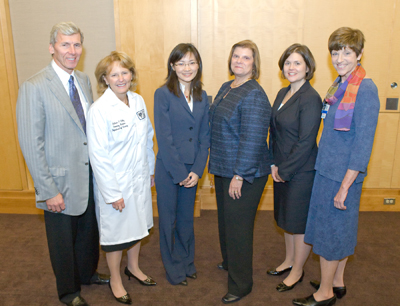Haley Nurse Forum Honors Nurse Scientists

From left, Steven and Kathleen Haley, Lichuan Ye, Susan Gennaro, Katherine Gregory and Trish Gibbons.
BWH nurses and faculty from the Boston College William F. Connell School of Nursing gathered for the Inaugural Haley Nursing Forum in Bornstein Amphitheater Oct. 26 to acknowledge and celebrate the Haley Nurse Scientist Program, made possible through the generosity of Steven and Kathleen Haley. “The Haley Nurse Forum highlights a special partnership between two special institutions,” said Chief Operating Officer Mairead Hickey, PhD, RN, FAHA, in welcoming remarks. “This partnership is not coincidental. Our similar missions and values focus on service, education, development and advancing the science of nursing.”
Through the Haley Nurse Scientist Program, nurse scientists from the Connell School of Nursing lead clinical nursing research and mentor BWH clinical nurses in scholarly work and clinical areas of concern for patients, families and nurses.
“The Haley Nurse Scientist Program and our partnership with Boston College allow us to bring nurse scientists into our clinical community so that we can create synergy between the art and the science of our discipline,” said Interim Chief Nursing Officer and Senior Vice President for Patient Care Services Trish Gibbons, DNSc, RN. “To have nurse scientist colleagues among us enables BWH nurses to explore important clinical questions and continue to add to the knowledge of the discipline.”
Program highlights included the introduction of Lichuan Ye, PhD, RN, as the second Haley Nurse Scientist and a presentation by the first Haley Nurse Scientist, Kate Gregory, PhD, RN, along with Cynthia Loring, RNC, MS, nurse educator and Jean Reilly, RN, BSN, clinical nurse, on their research conducted in the Neonatal ICU.
Ye studies sleep disorders in women and will spend the next year working with nurses at BWH on a research project related to her specialty.
“One of the most exciting aspects of research is the ability to ask good questions that come from clinical practice,” said Ye. “Obstructive sleep apnea is the most common sleep disorder in our patient population. One in five adults has a mild form of this disorder, making it a public health problem as great as smoking.”
Ye hopes to examine a number of factors relating to diagnosis and quality of life of patients with obstructive sleep apnea, including gender differences in the diagnosis and treatment of the disorder.
“While I am on this journey, I hope to learn from your clinical experience, to benefit patients, to promote patient care and to contribute to the science,” said Ye. “I am truly honored to be here, and to join my colleague Dr. Kate Gregory as a Haley Nurse Scientist.”
Gregory, who was named the first Haley Nurse Scientist in November 2009, presented the findings from “Temperature Control of the Late Preterm Infant: A Comparison of Thermoregulation following Two Bathing Techniques” with Loring and Reilly at the forum.
Late preterm infants are infants born between the 35th and 36 6/7th week of gestation. Thermoregulation of the late preterm infant is a significant clinical problem because of lower birth weight and a decreased amount of brown adipose tissue. Consequences of poor thermoregulation include hypoglycemia, respiratory distress, poor oral intake, hyperbilirubinemia and increased sepsis evaluations. These infants are especially at risk for themoregulation problems during and after bathing.
During the randomized control trial, researchers compared body temperature control of 100 late preterm infants at three time points before and after immersion tub bathing or sponge bathing.
“It was amazing how excited and supportive the staff in the NICU were,” said Gregory. “It took a lot of coordination and help from everyone.”
When the study began in February 2009, researchers hypothesized that immersion bathing would be significantly more effective in stabilizing late preterm infants’ body temperatures than sponge bathing.
“Our findings support our hypothesis, suggesting that late preterm infants bathed via immersion tub bathing have higher post-bath body temperatures, with less variation 30 minutes after the bath is completed when compared to infants who are sponge bathed,” said Loring. “In the coming months, we are planning to implement the results of the study to make sure these vulnerable late preterm infants are warmer during their baths.”